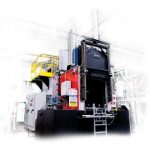Heat treatment of aluminum, quenching Part III
In the last article, we discussed quenching of aluminum, and the importance of rapid quenching to prevent the formation of precipitates at the grain...
Distortion during heating
Minimizing distortion involves more than just optimizing cooling
Stainless Steels
Kitchen sinks, refrigerator or oven doors, and tableware are what many people think of when they are asked what’s made from stainless steel (SS)....
Pyrometry, Industry Standards, & Temperature Uniformity Surveys
In its simplest sense, pyrometry is the measurement of temperatures. Practically speaking, in the business of heat treatment, the term also refers to the...
Gas Nitriding
In general, nitriding of parts involves a thermal process that provides a tough, corrosion-resistant, and wear-resistant surface with less distortion compared to other case...
Predicting hardness by the Grossman H-Value
In the last article, we described a method of calculating the Grossman H-Value . In the article before last, we described a method of...
Compelling reasons normalizing produces high quality gears
In this day and age, adding steps to the gear manufacturing process is not highly desirable unless the benefits far outweigh the costs incurred....
Vacuum Furnace Leaks
The process of finding leaks in your vacuum heat-treating system can sometimes be a lengthy process. However, a deeper understanding of best practices for...
Keeping your burners tuned
The backbone of any atmosphere furnace is the heating system. The heating system plays an essential role in keeping the furnace operating at peak...
Carburizing Optimization & ECD Precise Control
As discussed in the September/October 2016 Metal Urgency column , carburizing is a nonsteady-state diffusion process and thus can be expressed by Fick’s second...
Variation in Hardenability
Many heat-treating processes cannot tolerate appreciable variations in steel hardenability. For an established in-control process, deviations in chemical composition and starting microstructure may result...
Heat treatment of aluminum IV: Handling distortion
After quenching, depending on the quenchant used, distortion of parts can occur. This is particularly true for water-quenched parts. Parts must be straightened. This...
Heat-treatment of modified 9CrMo steel
The modified 9CrMo steels, such as Grade 91, Grade 92, and HT9, are materials of choice for fossil-fuel-fired power plants and Next Generation Nuclear...
Estimating required flow through quench tanks
In this month’s column, I will discuss a method of estimating the required flow for a quench tank.
Agitation has a significant effect on...
Hardenability – the influence of tramp elements
Hardenability is the property of a material to deeply harden, and not the ability to get hard . This basic concept has driven much...
Surface stress is key in rolling contact fatigue
Most bearing failures can be attributed to some form of rolling contact fatigue. Many factors influence rolling contact fatigue, but two main factors are...
Safety considerations when quenching with oil or salt
In this column, we will consider safety aspects of quenching with oil or molten salt.
Heat treating is a manufacturing process where the goal is...
Understanding the basics of spray quenching
Spray quenching involves the removal of heat by the impingement of a liquid quenchant on a hot metal surface. Examples include:
Fog quenching.
Quenching...
Creep deformation mechanisms in 9CrMo steel
The Generation-IV reactors in nuclear power plants are expected to address the growing energy demand by producing electricity and, at the same time, mitigating...
Hardening and tempering in the same cell
Tempering hardened steels is one of the most important heat treating processes used in part manufacturing. Induction tempering produces hardness and mechanical properties similar...
A brief history of the non-ferrous alloy aluminum
Non-ferrous alloys have caught my interest throughout my career, particularly aluminum. From its resistance to corrosion to its sensitivity at elevated temperatures, it is...
Kanthal APMT for nuclear-energy application
The major earthquake and tsunami that occurred in Japan in 2011 did serious damage to boiling water reactors of the Fukushima-Daiichi nuclear power plant....
Achieving results through cold treatment
Cold treatment is a sub-zero thermal treatment process primarily used to reduce the retained austenite content of alloy and high carbon steels. Cold treatment...
Q&A with David Wolff
What’s a typical day like for you at Nel Hydrogen?
I’m in field sales and work with customers to make sure their process needs that...
Handling temperature variations
Four essential maintenance steps for preserving temperature uniformity in your atmosphere furnace
Furnace Atmospheres
The makeup of a furnace’s atmosphere in the heat treating process varies depending upon the application. Sensor technology allows for the in-situ monitoring of...
The importance of contract review
Within any aspect of our business structure, understanding the specific requirements needed to produce product that conforms to customer requirements is important. These requirements...
Furnace Types
Heat treating furnaces consist of several subassemblies: insulation (fiber and brick), heating systems (electric and gas), material handling, quenching, atmosphere system, process and control...
Induction Hardening Choices for Gears
Of the various types of applied energy processing, induction hardening is the most common. Induction heating is a process that uses an alternating electrical...
The mechanism of creep and its stages
In this column, I will discuss the mechanism of creep and its three stages.
Applications of metals at elevated temperatures involve several problems. It is...
Q&A with Aziz Jamaluddin
What is Epcon?
Epcon is a full-service organization, starting with front-end business development/marketing, sales and application engineering, through complete in-house engineering, design, and drafting —...
Thermal triplets: PM, sintering, and case hardening
From my experience, powder metals (PM), sintering, and case hardening are three processes that could be said to be joined at the hip. More...
Enhanced properties of metal matrix nanocomposites
Application of carbon nanotube (CNT) reinforced metal matrix nanocomposite (MMNC) has been increasing rapidly since the discovery of CNT in the 1990s. These novel...
AMS2750E, Nadcap requirements
When I consult, I will periodically perform a gap analysis on a supplier’s heat-treat process to either obtain Nadcap approval or as a check-and-balance...
Q&A with Don Selmi
What is Premier’s mission?
To provide heat-treating systems that are dependable as well as innovative, with performance-proven technology that will enhance the physical properties and...
Troubleshooting induction hardening problems: Part 2
Last month, I began a two-part article about troubleshooting induction hardening problems and discussed possible corrections. This month, I will discuss biological and odor...
Register for IHEA’s Combustion and Safety Standards and Codes Seminars
The IHEA fall seminars will be October 31 and November 1. This year, IHEA will offer the Combustion Seminar and the Safety Standards and...
Atmosphere furnace control
Proper temperature is crucial to part quality, but don’t overlook its effect on atmosphere control
Simulation tools to effectively calculate process
One common goal for a wide range of industries has been to increase power density in shaft and gear components. The steel producing industry...
Quality staff: Understanding the technical side
Last month, we examined the history and heat-treatment of aluminum and how it applies to the quality functions of the industry. This month, we...










































